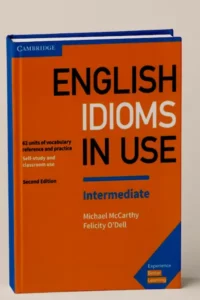English Idioms in Use Intermediate will help you to Improve your understanding of idioms in English and provide you with explanations and practice of English idioms for the Intermediate level.
Also Read: English Idioms in Use Advanced
English Idioms in Use Intermediate
English Idioms in Use Intermediate. Improve your understanding of idioms in English. Explanations and practice of English idioms, written for intermediate-level (B1 to B2) learners of English. Perfect for both self-study and classroom activities.
Learn idioms in context, with lots of different topics, including ‘Clothes’, ‘Music and theatre’ and ‘Work’. Be confident about what you are learning, thanks to Cambridge research into how English is really spoken and written, and get better at studying by yourself, with study tips, follow-up tasks and an easy to use answer key.
Why was this book written?
It was written to help you improve your knowledge of idioms in English. Idioms are fixed expressions whose meaning is not immediately obvious from looking at the individual words in the idiom. You will come across a great many idioms when you listen to and read English.
So it is important that you learn about the meanings of idioms and about how they are used. You can use this book either with a teacher or for self-study.
We wanted to encourage language learners to have a balanced approach to idioms in English. Sometimes in the past, teachers used to argue that it was a waste of time for learners to study idioms as they might start using them in an inaccurate or unsuitable way.
But idioms are in such widespread use that it is inappropriate to ignore them. This book focuses just on those idioms which the modern student needs to know and it aims to provide the information and practice which will help you understand and use them correctly.
Also Read: English Verbs
How were the idioms in the book selected?
There are a great many idioms in English, but some of them sound rather old-fashioned or are not very widely used. The idioms which are worked on in this book were mainly selected from those identified as significant based on computer searches of huge language databases:
the CAN CODE corpus of spoken English, developed at the University of Nottingham in association with Cambridge University Press, and the Cambridge International Corpus of written and spoken English (now known as the Cambridge International Corpus).
These databases show us how the idioms have actually been used by native speakers of English in conversations, newspapers, novels, and many other contexts.
The idioms selected are all also to be found in the Cambridge Advanced Learner’s Dictionary 4th Edition where additional examples and usage notes will also be found.
How is the book organised?
The book has 62 two-page units. The left-hand page presents the idioms that are worked on in the unit. You will usually find an explanation of the meaning of each idiom, an example of it in use and, where appropriate, any special notes about its usage.
The right-hand page checks that you have understood the information on the left-hand page by giving you a series of exercises that practise the material just presented. The exercises pay particular attention to checking your understanding of the idioms and how they are used because this is more important for most learners than being able to actively use the idioms.
The units are organised in three sections:
- Idioms to talk about … which groups idioms according to the topic area that they are used to talk about. Thus, be snowed under [have an enormous amount of work to do] is included in Unit 25, Work.
- Idioms from the topic area of .. . which groups idioms according to the image they are based on. Thus, hit the roof [react in a very angry way] is included in Unit 42, Houses and household objects.
- Idioms using these keywords which groups idioms according to keywords in them. For example, Unit 50 deals with a set of idioms based on the word head.
- The book also has a key to all the exercises and an index which lists the 1,000 idioms we deal with and indicates the units where they can each be found.
Also Read: All Cambridge IELTS Books
How should I use this book?
The first two units of the book, Unit 1, What are idioms? and Unit 2, Using your dictionary are introductory units. It is strongly recommended that you work through these units first. After that, you may work on the units in any order that suits you.
What else do I need in order to work with this book?
You need a notebook or file in which you can write down the idioms that you study in this book as well as any others that you come across elsewhere.
You also need to have access to a good dictionary. We strongly recommend the Cambridge Learner’s Dictionary as this gives exactly the kind of information that you need to have about idioms.
Your teacher, however, may also be able to recommend other dictionaries that you will find useful. So, we hope that this book will ‘shed light’ on all you need to know about English idioms (see Unit 9) and that, by the time you finish the units, you’ll be saying: ‘English idioms? A piece of cake!’ (see Unit 18).
Also Read: Oxford Dictionary Idioms

